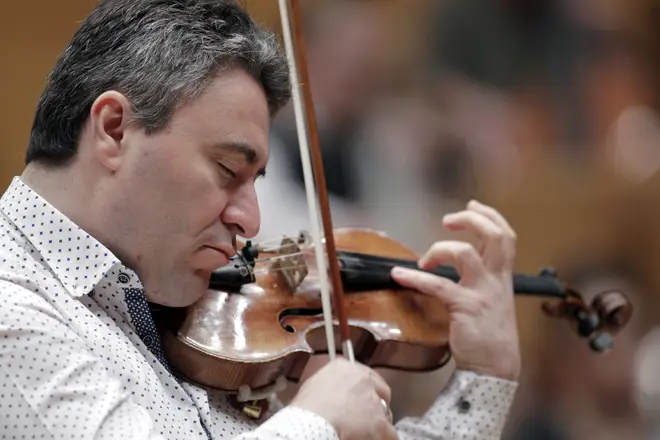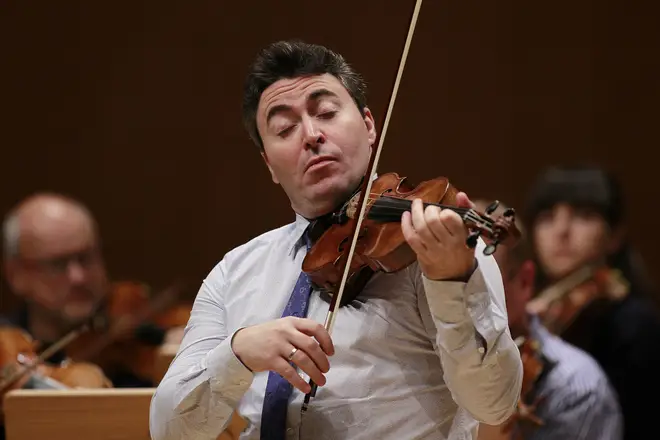On Air Now
The Classic FM Hall of Fame Hour 9am - 10am
7 April 2021, 17:30 | Updated: 8 April 2021, 08:54

Maxim Vengerov | 5 Best Violin Pieces | Classic FM
Classic FM’s Artist in Residence, Maxim Vengerov, reveals – and plays – the pieces of violin music closest to his heart.
“People often ask me ‘what are the five pieces you would take to a desert island?’,” Maxim Vengerov muses.
While conceding that it is far from an easy ask, the violin virtuoso and Classic FM’s first solo Artist in Residence has handpicked the five classical works closest to his own heart, as part of his masterclass series.
Special thanks to pianist Roustem Saïtkoulov, who played with Vengerov in real time between Monaco and Paris – a distance of nearly 1000km – while many parts of the world remain under lockdown.
Read more: Maxim Vengerov reveals, and plays, the five hardest violin pieces ever written >
“The final movement of the D minor partita can only be described as a monument,” Vengerov proclaims. “This consecration of emotion, through counterpoint and variations, uses all technical resources of the violin known at the time.”
Composed upon the composer’s return home from Dresden, the Chaconne is a sort of requiem, an outburst of anguish and remorse for Bach’s first wife and mother to seven of his children, Maria Barbara, who had died in his absence and already been buried.
As Vengerov recalls, over 100 years later Brahms wrote of this piece to Clara Schumann: “If I could only imagine myself capable of conceiving such a work, I am quite certain my sudden state of excitation would drive me mad.”

Vengerov - Bach - Partita No.2 - Chaconne
Eugène Ysaÿe, a Belgian virtuoso violinist and composer, dedicated each movement of his third sonata to a different violinist, weaving in techniques which matched their personalities and strengths.
The ‘Ballade’, he dedicated to one of the most phenomenal musicians to come from Romania, George Enescu.
“[Ysaÿe] was inspired to create a contemporary series of works for solo violin, exploiting the technical evolution of the instrument and modern expression,” Vengerov explains.
“In Enescu’s case, Ysaÿe gives us a stylised personal vision of the Romanian folk music so close to Enescu’s heart and compositions.”
Read more: Watch Maxim Vengerov’s exclusive at-home concert for Classic FM >

Maxim Vengerov - Eugene Ysaye - Sonata No 3 in D minor, Ballade Op. 27
The exquisite ‘Méditation’ is a “key magical moment” in Jules Massenet’s opera Thaïs, Vengerov explains, and one almost better known now as a concert piece.
We hear the intermezzo for solo violin and orchestra as the heroine, Thaïs, is confronted in the night by a Cenobite monk, Athanaël, who encourages her to leave Alexandria, become a Christian and go to the desert to save her soul.
For Vengerov the entrac’te, premiered in 1894 when Paris was considered the cultural capital of the world, represents “the essence of the orientalism of the Belle Epoque period”.
Read more: The most relaxing classical violin music ever written >

Jules Massenet / Thais / Meditation
“One of Mozart’s first incontestable masterpieces,” Vengerov asserts of Mozart’s 1779 Sinfonia Concertante in E flat major, which the composer penned following his return home from Paris.
“The declarations of tenderness and unity of the first movement are followed by one of Mozart’s most grieving and profound second movements. Whereas the finale is playful and reconciliatory.”
Hear Vengerov play an extract from the work at the top of this page.

Written at the time of the Zhdanov decree in Soviet Russia, Shostakovich’s First Violin Concerto had to wait until seven years after its composition to be premiered, after its composer was denounced for “anti-democratic” tendencies in his music.
In this great work, Vengerov explains, Shostakovich introduces his identifying motif – DSCH, using German note names – for the first time. He goes on to use it regularly in other compositions, including in his Tenth Symphony.
“[Soviet violinist] David Oistrakh, who revised the concerto with Shostakovich, described the first movement as ‘suppressed feelings’.
“The Scherzo, the second movement, was considered ‘demonic’. The following Passacaglia, a true masterpiece, uses Beethoven’s fate motif – and the famous DSCH motif appears in the grand cadenza.”
Watch above as Vengerov plays the work’s “wild” cadenza.

Click here to watch Maxim Vengerov’s exclusive violin masterclass videos for Classic FM.